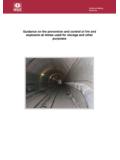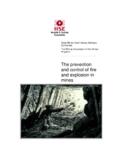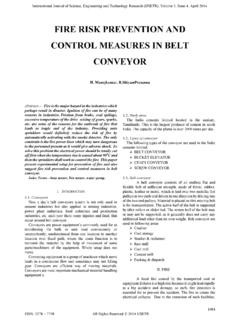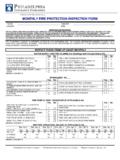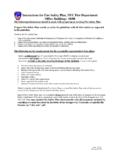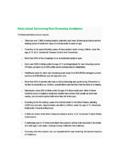Transcription of Hazard Prevention and Control in the Work Environment ...
1 Hazard Prevention and Control in the Work Environment : Airborne DustWHO/SDE/ 7 - Control of Dust TransmissionSection explained how dust could be controlled at emission, transmission or exposurestages. Chapter 6 dealt with Control of emission. If dust emissions cannot be eliminated orreduced to the desired level by Control of the source, ways to prevent dust transmissionthroughout the work Environment must be considered, and that is the subject of this principle is to separate the workers from the dust, either by containment (Section ),or by using general ( ) or local exhaust ( ) ventilation to remove the dusty air before itreaches the Containment (or isolation) and enclosuresContainment or isolation consists basically of placing a barrier between the dust sourceand the workers. It can be applied at the source or beyond the source, at any point up to theimmediate surroundings of the workers.
2 Isolation of the source implies a barrier between thehazard source and the work Environment , while isolation of the workers means, for example,a crane operator in a ventilated cabin. The containment/isolation principle also has simpleapplications: for example, placing a lid on a sieve can have a major impact in reducingexposure to fine explained in Section , it is in principle always preferable to Control at or close tothe source, so enclosure of the source is preferable to enclosure of the worker. Enclosure ofjust one worker allows a continuing risk of exposing others, and of contaminating theenvironment. Source enclosures are usually coupled with exhaust ventilation so they arekept under negative pressure; in this way contaminants are removed from the workplace,and any leakages are from the workplace into the ventilation system, so that dusty air doesnot re-enter the of exposure by total enclosure of process or handling system, if feasible, usuallyresults in large exposure reductions.
3 Examples include: enclosure of conveyor systems and successive transfer points where large amounts ofmaterial are being moved in mineral processing; total enclosure of the early stages of cotton processing including bale opening,blowing and carding; and totally enclosed systems for operations involving toxic materials in the Prevention and Control in the Work Environment : Airborne DustWHO/SDE/ Automated production and remotely controlled operations can be carried out insideenclosures without the presence of workers. Because protection will depend on theeffectiveness of the enclosure, it is important to routinely check such systems for leaks orany other type of loss of containment. Moreover, special procedures for maintenance andrepair are required and anyone entering the enclosed area for any reason should be very wellprotected in order to avoid extreme exposure (Section ).
4 Containment of a larger area can also be done as a means of preventing widercontamination, , temporary enclosure during asbestos insulation removal. However, ifwork is then done inside the enclosure, the enclosure becomes a workplace, and the rules ofdust Control must be applied inside it. Dust production must be minimized, for example byuse of wet methods. It is wrong to rely on personal protection of workers just because theyare in an enclosure, but for a substance like asbestos the workers must nevertheless be verywell protected inside the enclosure, with measures to prevent contamination as they leave,such as decontamination procedures, double lockers, etc. (HSE, 1990, 1999). Ventilation principles Buildings are usually ventilated for Control of temperature, odour, and general airbornecontaminants.
5 If suitably designed, this general ventilation can also be used as a Control ofairborne dust, and this also often helps reduce skin and clothing contamination, and dustdeposition on surfaces. If air is extracted from the locality where dust is produced, it isknown as local exhaust ventilation. Principles of general ventilation are covered in , and of local exhaust ventilation in Section The aim of these sections is to present basic principles and concepts, so that readers canwork with ventilation engineers to make sure that designs adequately meet the needs for asafe work Environment . The sections should also serve as an introduction for a moredetailed course in industrial ventilation for readers who wish to become proficient and havethe required technical background.
6 Detailed technical information on the design of industrial ventilation systems is beyondthe scope of this document; this subject has to be covered in specialized sources. ACGIH(1998) provides detailed technical information covering many specific installations. Gill(1995) gives a general introduction going into more detail than these treatments include Burgess et al. (1989) and Burton (1997). Nationalagencies have also provided valuable specific guidance, for example, HSE (1990, 1992,1993, 1997, 1998, 1999), INRS (1984, 1985, 1986, 1992, 1993, 1996) and NIOSH (see Website in Chapter 11). The existence of a ventilation system is no guarantee that airborne contaminants are undercontrol; quality assurance on installation of the system and routine checks thereafterHazard Prevention and Control in the Work Environment : Airborne DustWHO/SDE/ essential, in order to ensure effective and continued performance.
7 Many mistakes mayoccur in the design and installation. Moreover, even well designed and initially efficientsystems, if not well maintained, will eventually deteriorate, which results in decreasedperformance, and insufficient protection. For example, if the leads to a centrifugal fan motorare accidentally reversed (and this does happen), it will still apparently function but will onlyprovide about 20 - 30% of the original flow. Such situations are particularly dangerous because workers will then be unknowinglyoverexposed, and will not take other preventive precautions since they will have a falsebelief that they are already protected. The cost of installing and operating a poorly designed,hence inefficient, system may be as great as, or greater than, a well designed effectivesystem.
8 General ventilation The term general ventilation refers to the supply and exhaust of large volumes of air at aworkplace, with the purpose of diluting or displacing airborne contaminants, with or withoutlocal exhaust ventilation, and for ensuring thermal comfort. It can be effective in controllingrelatively low concentrations of low toxicity airborne contaminants originating from manyscattered sources in a workroom. However, it is not recommended for Control of largeamounts of contaminants, which should be removed before being spread into the is always a danger that general ventilation will increase exposure of people distantfrom the dust source or outside the workplace. In the special circumstances of undergroundmining, general ventilation is often necessary to Control fire risk and the thermalenvironment; and it then becomes an important means of dust Control also; but mineventilation is a specialized field.
9 General ventilation may be natural or forced. Natural ventilation makes use of thebuoyancy of the inside warm air. Outlets at the ceiling, perhaps aided by exhaust fans, andinlets of cooler air at floor level, can induce a steady flow. However, this may not givesatisfactory thermal Control , and may be particularly susceptible to changes in outdoorweather conditions. Forced ventilation is driven by inlet and exhaust fans, supplying air tothe workplace and then removing it. When using general ventilation, whether natural or forced, the correct location of airinlets and outlets, any exhaust fans, dust sources, workstations and workers are of paramountHazard Prevention and Control in the Work Environment : Airborne DustWHO/SDE/ Contaminants should be directed away from the workers breathing zones,which may be difficult to achieve, particularly when operations are scattered.
10 A badarrangement can mean that air moves from inlet to exhaust, bypassing workers and dustsources. Clearly, workers should where possible be on the clean side of the dust when the arrangement is right, it must be remembered that dust usually mixes withventilation air and does not move in a stream from the source to the outside through the mixing will spread the dust through a large part of the air of the room, as indicatedin Figure 7-1. Another problem is that an air current coming from the back to the front ofthe body, can form turbulent eddies which bring the contaminated air up to the breathingzone, as illustrated in Figure 7-2. Figure 7-1 - Schematic Visualization of General Ventilation (INRS, 1996: by courtesy of INRS - Institut national de Recherche et de S curit , France) Hazard Prevention and Control in the Work Environment : Airborne DustWHO/SDE/ Figure 7-2 -Effects of Air Displacement in Ventilation, seen from above: (a) eddies ofcontaminated air pull the contaminant directly into the worker's breathing zone;(b) satisfactory position for worker in order to avoid inhaling contaminant(WHO, 1992) In order to be effective, clean air should sweep through the work area, between the floorand a height of 3 metres.










